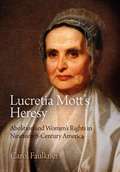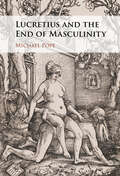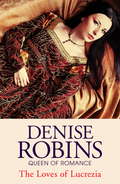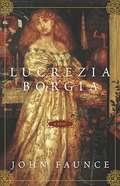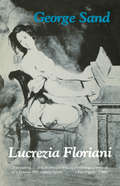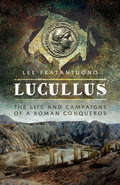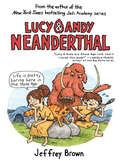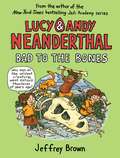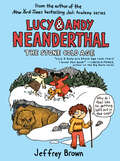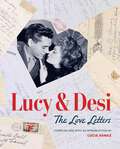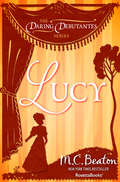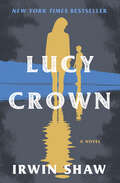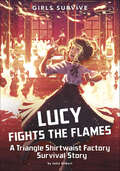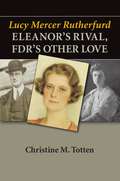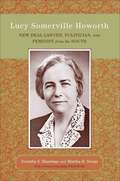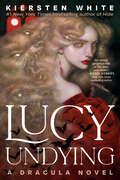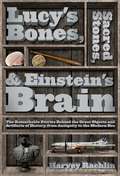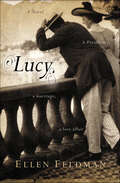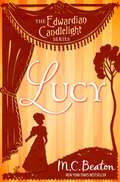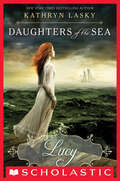- Table View
- List View
Lucretia Mott's Heresy
by Carol FaulknerLucretia Coffin Mott was one of the most famous and controversial women in nineteenth-century America. Now overshadowed by abolitionists like William Lloyd Garrison and feminists such as Elizabeth Cady Stanton, Mott was viewed in her time as a dominant figure in the dual struggles for racial and sexual equality. History has often depicted her as a gentle Quaker lady and a mother figure, but her outspoken challenges to authority riled ministers, journalists, politicians, urban mobs, and her fellow Quakers.In the first biography of Mott in a generation, historian Carol Faulkner reveals the motivations of this radical egalitarian from Nantucket. Mott's deep faith and ties to the Society of Friends do not fully explain her activism--her roots in post-Revolutionary New England also shaped her views on slavery, patriarchy, and the church, as well as her expansive interests in peace, temperance, prison reform, religious freedom, and Native American rights. While Mott was known as the "moving spirit" of the first women's rights convention at Seneca Falls, her commitment to women's rights never trumped her support for abolition or racial equality. She envisioned women's rights not as a new and separate movement but rather as an extension of the universal principles of liberty and equality. Mott was among the first white Americans to call for an immediate end to slavery. Her long-term collaboration with white and black women in the Philadelphia Female Anti-Slavery Society was remarkable by any standards. Lucretia Mott's Heresy reintroduces readers to an amazing woman whose work and ideas inspired the transformation of American society.
Lucretius
by E. J. KenneyThe De Rerum Natura of Lucretius is a sustained and impassioned protest against religious superstition and irrationality. The poem takes the form of a detailed exposition of Epicurean physical theory - an extreme materialism designed to remove and discredit popular fears of the gods, death and an afterlife. Book III is generally accepted to be the finest in the whole poem; Lucretius argues there that the soul is as mortal as the body and shows that human response to the fact of mortality and death can be at once rational, dignified and liberating. Professor Kenney's commentary is the first to give proper critical emphasis to the techniques and intentions of Lucretius' poetry; it can be read with profit by all students of Latin from senior school level upwards.
Lucretius and the End of Masculinity
by Michael PopeFrom beginning to end, the De rerum natura upsets expectations. This book's premise is that Lucretius intentionally provokes his imagined male audience, playfully and forcefully proving to them that they are not the men they suppose themselves to be. From astral bodies to the magnetic draw of human sexuality to the social bonds linking parents to children, Lucretius shows that everything is compounded material, both a source of atomic issue and receptacle of atomic ingress. The universe, as Lucretius presents it, is a never-ending cycle of material interpenetration, connectivity, and dissolution. Roman men, in the vastness of it all, are only exceptional in their self-defeating fantasies. Close analysis of Lucretius' poetics reveals an unremitting assault upon the fictions that comprise Roman masculinity, from seminal conception in utero to existential decomposition in the grave. Nevertheless, Lucretius offers an Epicurean vision of masculinity that just might save the Republic.
Lucrezia
by Denise RobinsThe wickedest woman who ever loved.Sensual... corrupt... that was the court of Renaissance Italy. And that, too, was Lucrezia Borgia - a woman of infinite guile and indiscriminate passion, whose affairs led her from page boy to prince... and to a reputation called shocking even in a land not easily shocked.Yet no matter how often she strayed, Lucrezia remained faithful - in her special fashion - to the one man she had sworn would be hers. A gripping historical romance from the 100-million-copy bestselling Queen of Romance, first published in 1953, and available now for the first time in eBook.
Lucrezia
by Denise RobinsThe wickedest woman who ever loved. Sensual... corrupt... that was the court of Renaissance Italy. And that, too, was Lucrezia Borgia - a woman of infinite guile and indiscriminate passion, whose affairs led her from page boy to prince... and to a reputation called shocking even in a land not easily shocked. Yet no matter how often she strayed, Lucrezia remained faithful - in her special fashion - to the one man she had sworn would be hers. A gripping historical romance from the 100-million-copy bestselling Queen of Romance, first published in 1953, and available now for the first time in eBook.
Lucrezia Borgia: A Novel
by John Faunce"A fascinating story, rich in detail. In every case, Faunce portrays [Lucrezia] believably, with wit and sensitivity. "--Library Journal Hundreds of years after her death, Lucrezia Borgia remains one of the most enigmatic and notorious women of history, accused of incest, of poisoning her rivals, and even of murdering her own father. Born into scandal, she was the daughter of the treacherous Cardinal Roderigo Borgia, who would later be crowned Pope Alexander VI. When her father ascended the papal throne, young Lucrezia's life changed forever. From then on, Lucrezia would be unable to escape the political ambitions of her father and her brother, the bloodthirsty Cesare Borgia. In an era when the Vatican was as decadent and violent as any royal court, Lucrezia was its crown princess. Famed for her beauty, she was a valuable pawn in the marriage game, and Alexander VI would use her to create one alliance after another. When her kindly first husband no longer suited the Pope's needs, Lucrezia's virginity was restored by papal decree (her new maidenhood was declared "miraculous"), and she was married off again, this time to a man she truly loved, Alfonso, Prince of Naples. But her joy was short-lived. Alfonso loathed her brother and refused to participate in the Pope's imperial schemes, which threatened to tear apart the Vatican's political alliances--and Lucrezia's happy marriage. In this unforgettable debut, John Faunce perfectly captures the rotten decadence of the Borgias' papal court and the inner steel of Lucrezia Borgia, one of history's great survivors. "Fascinating. . . a searing portrait of an intelligent woman, cunning enough to shape her own bizarre destiny. "--Booklist
Lucrezia Borgia: Life, Love, and Death in Renaissance Italy
by Sarah BradfordTake a road trip with the undead . . . in this latest in the argeneau series by New York Times bestselling author Lynsay Sands For Basha Argeneau, anything is better than facing her estranged family. Even hiding out in sweltering southern California. But when a sexy immortal in black shows up determined to bring her back to the clan, she'll do anything to keep far, far away from the past she can't outrun. Marcus Notte isn't here to play games—especially not with someone as crazy as the infamous blonde. Asked by Lucian Argeneau to bring her back for questioning, Marcus is determined to carry out Lucian's request—no matter how the seductive little mind-reading vamp feels about it. Basha doesn't mind fighting fire with fire, especially with a hot immortal involved. But if he wants to take her away, he'll have to catch her first . . .
Lucrezia Floriani
by George Sand Julius EkerLucrezia Floriani, a worldly 30-year-old actress and the mother of 4 children with 3 different fathers, meets and falls in love with Prince Karol, a moody, introspective aristocrat.
Lucrezia Marinella (Elements on Women in the History of Philosophy)
by Marguerite DeslauriersLucrezia Marinella's (1571–1653) most important contributions to philosophy were two polemical treatises: The Nobility and excellence of Women, and the Defects and Vices of Men, and the Exhortations to Women and to Others if They Please. Marinella argues for the superiority of women over men in every respect: psychologically, physiologically, morally, and intellectually. She is particularly effective in using the resources of ancient philosophy to support her various arguments, in which she draws conclusions about the souls and the bodies of women, the nature and significance of women's beauty, the virtue of women and the liberty to which women as well as men are entitled. This Element showcases that her claim of superiority is intended ultimately to justify the possibility of political rule by women.
Lucullus: The Life and Campaigns of a Roman Conqueror
by Lee FratantuonoThe military achievements of Lucius Licinius Lucullus (118-57/56 B.C.) have been the subject of admiration and great respect throughout the history of the study of warfare. Yet there have been few studies dedicated to a comprehensive examination of exactly how Lucullus conquered the Roman East and made it a more or less cohesive part of the empire. Lee Frantantuono considers every aspect of Lucullus life, starting with the training and education of a future Roman officer, but the greatest emphasis is on his military strategy and tactics during the Third Mithridatic War and his military adventures in Armenia. His most famous achievement was his victory against immense odds at the land battle of Tigranocerta. We are also reminded that he one of the most formidable naval strategists of the Roman Republic. Lucullus complicated relationship with Sulla and Crassus is explored and the study concludes with the retirement of the man Pliny the Elder memorably referred to as 'Xerxes in a Toga', a patron of the arts and master of a life of horticulture and reflection.
Lucy & Andy Neanderthal (Lucy and Andy Neanderthal #1)
by Jeffrey BrownFrom the author of the New York Times bestselling Jedi Academy books comes a hilarious graphic novel series about two young cave kids living 40,000 years ago.&“Lucy & Andy are Stone Age rock stars! I loved this book!&” —Lincoln Peirce, author of the Big Nate series Lucy and Andy are a sister and brother who get into trouble much like any sister and brother. Only difference? Lucy and Andy live in the Stone Age! Discover their laugh-out-loud adventures as the Paleo pair take on a wandering baby sibling, bossy teens, cave paintings, and a mammoth hunt. But what will happen when they encounter a group of humans?Includes extra information about Neanderthal life that's sure to appeal to future paleontologists and science phobes alike! And don't miss Lucy and Andy's next outing, Lucy & Andy Neanderthal: The Stone Cold Age -- coming soon!A New York City Public Library Best 50 Books for Kids 2016!A Chicago Public Library Best of the Best 2016!"Jeffrey Brown returns from a galaxy far, far away to bring us a whole new slew of kid-friendly characters! Just beware of mammoth dung!" —Keith Knight, author of Jake the Fake and The Knight Life Every kid will love to go back in time with LUCY & ANDY!" —Judd Winick, author of Hilo: The Boy Who Saved the World
Lucy & Andy Neanderthal: Bad to the Bones (Lucy and Andy Neanderthal #3)
by Jeffrey BrownFrom the author of the New York Times bestselling Jedi Academy books comes book three in the laugh-out-loud graphic novel series about cave kid siblings Lucy and Andy. Fans of Big Nate, Diary of a Wimpy Kid, and The Terrible Two won't want to miss it!"Lucy & Andy are Stone Age rock stars! I loved this book!" -LINCOLN PEIRCE, author of the BIG NATE series Lucy and Andy have some extra space in the cave now the humans have moved out. But they do miss hanging with Sasha and Tommy. Luckily, their new friends live right around the ice block, close enough to form the first-ever explorer's club! These adventurers are on the hunt. Their first big discovery: dinosaur bones!Jeffrey Brown masterfully blends facts with funny in this graphic novel series. Includes theories about how Neanderthals went extinct; a timeline covering the history of Earth, dinosaurs, Neanderthals, and present day; museums, caves, and paleontologists of note; and Neanderthal Fact vs. Fiction."Lucy & Andy are Stone Age rock stars! I loved this book!" --Lincoln Peirce, author of the Big Nate series"Every kid will love to go back in time with Lucy & Andy!" --Judd Winick, author of Hilo: The Boy Who Saved the World"Jeffrey Brown returns from a galaxy far, far away to bring us a whole new slew of kid-friendly characters!" --Keith Knight, author of Jake the Fake and The Knight Life
Lucy & Andy Neanderthal: The Stone Cold Age (Lucy and Andy Neanderthal #2)
by Jeffrey BrownFrom the author of the New York Times bestselling Jedi Academy books comes book two in the laugh-out-loud graphic novel series about Neanderthal siblings Lucy and Andy. Fans of Big Nate, Diary of a Wimpy Kid, and The Terrible Two won&’t want to miss it! &“Lucy & Andy are Stone Age rock stars! I loved this book!&” —Lincoln Peirce, author of the Big Nate series Neanderthal siblings Lucy and Andy are back to their paleo pranks. This time, they have to put up with more than just each other—the cave is feeling awfully cramped since the humans moved in. They&’re in the Ice Age, and legroom comes at a real premium! Jeffrey Brown skillfully blends humor and history with paleontologist sections: Timeline of Key Discoveries, Ice Age Fact vs. Fiction, Silly Cavemen Myths, and more. "A fast, funny read" –Kirkus Reviews
Lucy & Desi: The Love Letters
by Lucie ArnazA treasure trove of previously unseen love letters between Lucille Ball and Desi Arnaz, spanning their courtship through I Love Lucy fame and beyond, tells the couple&’s real-life love story in their own words, alongside rare photos from the family scrapbooks. After Lucille Ball&’s death in 1989, dozens of private letters between Lucy and Desi Arnaz were discovered. Now, for the first time, daughter Lucie Arnaz shares the complete collection in this remarkable volume that reveals the romance of one of the most famous couples in history more intimately than anything that has ever been written about them. At turns the letters disclose longing, ambition, jealousy, humor, and, above all, a passionate love affair that has claimed the world&’s interest for more than half a century. This extraordinary collection takes readers back to America during World War II, to the lives of a young couple in the early years of their relationship, with budding careers in Hollywood that were still far from their heyday as the nation&’s top stars. Each letter contains a bit of history as they talk about where they are, what they are doing, and what is going on in the world around them—whether it be a wardrobe fitting with a celebrated designer, remembering the last sensuous night they spent together, or trying to buy just the right refrigerator to please your mother-in-law during wartime rationing. Lucille Ball and Desi Arnaz weremarried from 1940 to 1960, and while the bulk of the letters were written in the early 1940s, the compendium reflects their entire relationship, from an early courtship, through long periods of separation due to work and world events, to a bittersweet end after nearly two decades. This stunning book takes readers as close as possible to the actual letters by featuring reproductions complete with envelopes, stamps, postmarks, and Lucy and Desi's own custom stationery. Further illustrated by rare photos from the Arnaz family scrapbooks, this volume is a revelatory look at a complicated and captivating love story that will amaze even longtime fans who think they have seen it all.
Lucy (The Daring Debutantes Series #4)
by M. C. BeatonTwo servants team up to fool London society in this Edwardian romance by the New York Times–bestselling author of the Agatha Raisin mysteries.She is a lady&’s maid who longs to be a lady. How else can Lucy Balfour hope to win the favor of Andrew, Viscount Harvey, the toast of the town, who seems ready to take a bride at last? There is only one way to command his attention. It seems an impossible dream. Even the first step is daunting: Lucy must become the peer of her own mistress, the coldly beautiful Lady Angela, who is also determined to claim Andrew as her own. But there is Hamish MacGregor, the wily old butler, who promises to make Lucy&’s dream come true. With Lucy&’s unaccountable good luck at baccarat, they can win a fortune. With his cunning, they may conquer London society as &“father&” and &“daughter&” and meet the king himself! Having served the rich, he knows how they operate, and Hamish MacGregor is determined to beat them at their own game. And having met Andrew Harvey, Lucy Balfour determines she will never be a servant again…ABOUT THE COLLECTION The seven heroines of the Daring Debutantes Collection set out to conquer London&’s glittering high society and the marriage mart. These headstrong women cannot help but keep London society dangling on a string, but will they find a husband or lose themselves in the game?
Lucy Crown: A Novel
by Irwin ShawA New York Times bestseller from an author with &“a natural gift for storytelling&”: A mother and son are reunited years after a shattering betrayal (The New York Times). She passes through the Paris restaurant, alone, unbent, and unbroken. Lucy Crown has lived with heartbreak for long enough that it no longer shows on her face, and she&’s not afraid to dine in solitude. But then she sees him across the bar, full of liquor and life, looking far happier than he did the last time she saw him two decades before: Tony, her son—the one man she loved more than any other, the one she nearly destroyed. Twenty years earlier, in 1937, Lucy was an unhappily married suburban housewife, and Tony was so frail his parents were forced to hire a companion for him. When the companion caught Lucy&’s eye, he awoke in her a feeling of passion she thought had died long ago—leading to an act of indiscretion during a vacation in Vermont that would upend their family, and take half a lifetime to repair. From the author of such classics as Rich Man, Poor Man and The Young Lions—an O. Henry Award winner who &“always writes immensely readable books&”—Lucy Crown is an unflinching look at the emotional reality of infidelity, heartbreak, and divorce that remains a testament to the power of forgiveness (The New York Times). This ebook features an illustrated biography of Irwin Shaw including rare images and never-before-seen documents from the author&’s estate.
Lucy Fights the Flames: A Triangle Shirtwaist Factory Survival Story (Girls Survive)
by Julie GilbertIn 1911, fourteen-year-old Lucy Morelli lives with her parents, older brother, and several youngers siblings in a crowded apartment in the Greenwich Village neighborhood of New York City. Lucy dreams of going to college, but her Italian immigrant family relies heavily on her income from the Triangle Shirtwaist Factory to survive. Lucy finds the factory work boring, but the working conditions are better than many other jobs. But when Lucy and her best friend, Rosie, head to work one Saturday in March, everything changes. Fire breaks out in the factory, and the doors are locked, trapping hundreds of workers inside. Lucy must battle the flames to save her own life -- and Rosie's. Readers can learn the real story of the Triangle Shirtwaist Factory fire, one of the deadliest industrial disaster's in U.S. history, from the nonfiction backmatter in this Girls Survive story. A glossary, discussion questions, and writing prompts are also provided.
Lucy Mercer Rutherfurd: Eleanor's Rival, FDR's Other Love
by Christine M. TottenWhat more could there be to know about FDR, given how exhaustively his life has been written about? As it happens, there is more and that focuses on Lucy Mercer Rutherfurd, the queen of her Washington social circle, later FDR's friend and love-and Eleanor's rival, as the title of Christine Totten's work points out. In Lucy Mercer Rutherfurd: Eleanor's Rival, FDR's Other Love, Totten presents a carefully structured case for a deep and lasting but chaste love between Lucy and FDR, against the prevailing view that they were clandestine lovers. Totten's research into the personal memories of the Rutherfurd family and the public holdings of the FDR Library establishes a new rich understanding of Lucy Mercer Rutherfurd--her early life, her education, and her role in the social and political scene in Washington. This work gives Lucy Mercer Rutherfurd her due, as a woman in her own right as well as FDR's valued soul mate and friend.
Lucy R. Lippard on Pop Art (Pocket Perspectives #0)
by Lucy LippardExplore the dynamic world of 1960s pop art through Lucy Lippard's insightful analysis of this groundbreaking international art movement. Surprising, questioning, challenging, enriching: the Pocket Perspectives series presents timeless works by writers and thinkers who have shaped the conversation across the arts, visual culture, and history. Celebrating the undiminished vitality of their ideas today, these covetable and collectable little books embody the best of Thames & Hudson.
Lucy Somerville Howorth: New Deal Lawyer, Politician, and Feminist from the South (Southern Biography Series)
by Anne Firor Scott Dorothy S. Shawhan Martha H. SwainBorn, raised, and retired in Mississippi, Lucy Somerville Howorth (1895--1997) was a champion for the rights of women long before feminism emerged as a widely recognized movement. As told by Dorothy S. Shawhan and Martha H. Swain, hers is a remarkable life story-from a small-town upbringing to a career as an attorney, an activist, and the last of a generation of New Deal women in Washington, D.C. She held a presidential appointment under every chief executive from Franklin Roosevelt to John Kennedy.Howorth was a fervent believer in the power of organizations to bring about change, and she became known for her leadership qualities, acumen, and quick appraisal of social problems, particularly as they affected women. Shawhan and Swain point out that her winsome personality, small stature, and delightful sense of humor also aided her as a female aspiring in a man's world. In 1931 she was elected to the Mississippi House of Representatives and, after campaigning for Roosevelt, was rewarded by the new president with a federal appointment. She served in a number of subsequent roles, rising to become general counsel of the War Claims Commission, at that time the highest legal position in an executive commission ever filled by a woman.Howorth worked relentlessly for the advancement of women, especially through the American Association for University Women and the National Federation of Business and Professional Women. She lobbied for equality in the workplace, helping to effect significant advances in government and the professions. In 1944, at the request of Eleanor Roosevelt, Howorth delivered the keynote speech at the White House Conference on Women in Postwar Policy-Making, the most memorable of her many public addresses.This first-ever biography of Howorth bestows long-overdue recognition of her many notable achievements and illuminates the activism of women in the decades often considered to be the doldrums of the women's movement.
Lucy Undying: A Dracula Novel
by Kiersten WhiteA vampire escapes the thrall of Dracula and embarks on her own search for self-discovery and true love in this epic and seductive gothic fantasy from the #1 New York Times bestselling author of Hide.&“Fiercely empowering and gloriously vengeful.&”—Heather Walter, award-winning author of MaliceA CRIMEREADS BEST BOOK OF THE YEARHer name was written in the pages of someone else&’s story: Lucy Westenra was one of Dracula&’s first victims.But her death was only the beginning. Lucy rose from the grave a vampire and has spent her immortal life trying to escape from Dracula&’s clutches—and trying to discover who she really is and what she truly wants.Her undead life takes an unexpected turn in twenty-first-century London, when she meets another woman, Iris, who is also yearning to break free from her past. Iris&’s family has built a health empire based on a sinister secret, and they&’ll do anything to stay in power.Lucy has long believed she would never love again. Yet she finds herself compelled by the charming Iris while Iris is equally mesmerized by the confident and glamorous Lucy. But their intense connection and blossoming love is threatened by outside forces. Iris&’s mother won&’t let go of her without a fight, and Lucy&’s past still has fangs: Dracula is on the prowl once more.Lucy Westenra has been a tragically murdered teen, a lonesome adventurer, and a fearsome hunter, but happiness has always eluded her. Can she find the strength to destroy Dracula once and for all, or will her heart once again be her undoing?
Lucy's Bones, Sacred Stones, & Einstein's Brain: The Remarkable Stories Behind the Great Objects and Artifacts of History, From Antiquity to the Modern Era
by Harvey RachlinLeap across time with bestselling author Harvey Rachlin as he collects over 50 of the most fascinating objects in the world, under one book. The Mounted Hide of Stonewall Jackson's Battle Horse, The Black Obelisk, The Rosetta Stone, George Washington's False Teeth, Vice Admiral Lord Nelson's Uniform Coat, The Elephant Man's Skeleton, and Lincoln's Death Bed are just some of the objects Rachlin explores with wit, pick and an amazing sense of spectacle. Publisher's Weekly calls Lucy's Bone's, Sacred Stones, and Einstein's Brain "entertaining and enlightening." Library Journal declares Rachin's work "fascinating." Parade says it is "detailed and authoritative." It is also intensely moving as Rachlin weaves together seemingly disparate histories into a holistic statement that celebrates human endeavor. This book is not simply wonderful -- it is full of wonder.
Lucy: A Novel
by Ellen FeldmanAn utterly absorbing novel about a famous political marriage and an epic infidelity. On the eve of World War I, Assistant Secretary of the Navy Franklin Delano Roosevelt, fiercely ambitious and still untouched by polio, falls in love with his wife's social secretary, Lucy Mercer. Eleanor stumbles on their letters and divorce is discussed, but honor and ambition win out. Franklin promises he will never see Lucy again. But Franklin and Lucy do meet again, and again they fall in love. As he prepares to run for an unprecedented third term and lead America into war, Franklin turns to Lucy for the warmth and unconditional approval Eleanor is unable to give. Ellen Feldman brings a novelist's insight to bear on the connection of these three compelling characters. Franklin and Lucy did finally meet, across the divide of his illness and political ascendancy, her marriage and widowhood. They fell in love again. As he prepared to run for an unprecedented third term and lead America into war, Franklin turned to Lucy for the warmth and unconditional approval Eleanor was unable to give. Drawing on recently discovered materials to re-create the voice of a woman who played a crucial but silent role in the Roosevelt presidency, Lucy is a remarkably sensitive exploration of the private lives behind a public marriage. Reading group guide included.
Lucy: Edwardian Candlelight 12 (Edwardian Candlelight #12)
by M.C. BeatonThe twelfth book in M.C. Beaton's charming Edwardian Candlelight series.She was a lady's maid who longed to be a lady. How else could Lucy Balfour hope to win the favor of Andrew, Viscount Harvey, the toast of the town, who seemed ready to take a bride at last? There was only one way and that was to command his attention. It seemed an impossible dream; first she had to become the peer of her own mistress, the coldly beautiful Lady Angela, who was determined to claim Andrew as her own.But there was Hamish MacGregor, the wily old butler, who promised to make Lucy's dream come true. With Lucy's unaccountable good luck at baccarat, they could win a fortune. With his cunning, they would conquer London society as "father" and "daughter" and meet the king himself! Having served the rich, he knew how they operated and Hamish MacGregor was determined to beat them at their own game. And having met Andrew Harvey, Lucy Balfour determined she would never be a servant again.The Edwardian Candlelight Series chronicles young, passionate girls who come to understand the nature of true love despite overwhelming odds. From a penniless pauper, a stenographer, a governess to an accused murderess, these ladies in love overcome incredible odds with grit and sophistication to find and keep true love.
Lucy: Lucy (Daughters Of The Sea #3)
by Kathryn LaskyA choice between love and survival . . .Lucy's family is excited to spend the summer in Bar Harbor, Maine. Her minister father is pleased to preside over such a prestigious congregation, and his social-climbing wife is ecstatic at the chance to find a rich husband for her daughter. Yet Lucy wants nothing to do with the Bar Harbor social scene; she's simply excited to spend the summer by the sea, watching the waves from her favorite spot on the cliff. Despite having never gone swimming, Lucy feels an intense connection to the ocean, and meets a handsome ship-builder who shows Lucy a world she's never known, yet somehow always longed for. However, her mother will stop at nothing to keep Lucy and the ship builder apart, even if it means throwing Lucy into the arms of a wealthy man with a dangerous secret. Can Lucy break free and embrace her destiny as a daughter of the sea? Or is she doomed to waste away in a gilded cage, slowly dying of a broken heart?
